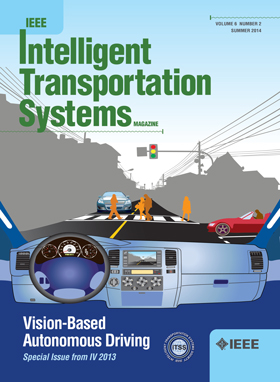Dissipating Traffic Waves in Mixed Vehicle Platoons: A Controller-Matching-Based Double-Layer Distributed Model Predictive Control Approach
IF 8.4
1区 工程技术
Q1 ENGINEERING, CIVIL
IEEE Transactions on Intelligent Transportation Systems
Pub Date : 2025-06-10
DOI:10.1109/TITS.2025.3575540
引用次数: 0
Abstract
This study proposes a novel distributed model predictive control (DMPC) approach for mixed vehicle platoons (MVPs), which achieves driving safety, asymptotic stability, and traffic wave dissipation simultaneously. The longitudinal dynamics model and safety constraints are first established for each vehicle. The MVPs are divided into several sub-platoons according to the distribution of connected-and-automated vehicles (CAVs) and human-driven vehicles (HDVs). Then, a compound controller to ensure the head-to-tail string stability of MVPs is constructed as a reference controller for the subsequent design of the double-layer distributed model predictive controller (DL-DMPC). To describe the behavior of human drivers, a car-following model specific to HDVs is developed. On the basis of the designed compound controller and the description of HDVs, the DL-DMPC is proposed. The first layer improves tracking performance and satisfies the state constraints of each CAV under different communication topologies through an optimization problem. The second layer utilizes controller-matching technology to ensure the asymptotic stability of vehicle platoons and dissipate traffic waves. With the above double-layer structure, the DL-DMPC can simultaneously address multiple tasks and is applicable in various communication topologies. Simulations and analyses based on the NGSIM dataset are conducted in various scenarios to validate the effectiveness of the developed approach.混合车辆队列交通波的消散:一种基于控制器匹配的双层分布式模型预测控制方法
提出了一种新型的混合车辆队列分布式模型预测控制(DMPC)方法,该方法可以同时实现混合车辆队列的行驶安全性、渐近稳定性和交通波耗散。首先建立了每辆车的纵向动力学模型和安全约束。根据联网和自动驾驶车辆(cav)和人类驾驶车辆(hdv)的分布,mvp被分成几个子排。在此基础上,构造了一种复合控制器,以保证mvp的首尾稳定,作为后续设计双层分布式模型预测控制器(DL-DMPC)的参考控制器。为了描述人类驾驶员的行为,开发了一种针对hdv的汽车跟随模型。在设计复合控制器的基础上,根据hdv的描述,提出了DL-DMPC。第一层通过优化问题提高跟踪性能,满足各CAV在不同通信拓扑下的状态约束。第二层采用控制器匹配技术,保证车辆排的渐近稳定,并消除交通波。DL-DMPC采用上述双层结构,可以同时处理多个任务,适用于各种通信拓扑。基于NGSIM数据集在不同场景下进行了仿真和分析,以验证所开发方法的有效性。
本文章由计算机程序翻译,如有差异,请以英文原文为准。
求助全文
约1分钟内获得全文
求助全文
来源期刊

IEEE Transactions on Intelligent Transportation Systems
工程技术-工程:电子与电气
CiteScore
14.80
自引率
12.90%
发文量
1872
审稿时长
7.5 months
期刊介绍:
The theoretical, experimental and operational aspects of electrical and electronics engineering and information technologies as applied to Intelligent Transportation Systems (ITS). Intelligent Transportation Systems are defined as those systems utilizing synergistic technologies and systems engineering concepts to develop and improve transportation systems of all kinds. The scope of this interdisciplinary activity includes the promotion, consolidation and coordination of ITS technical activities among IEEE entities, and providing a focus for cooperative activities, both internally and externally.
 求助内容:
求助内容: 应助结果提醒方式:
应助结果提醒方式:


